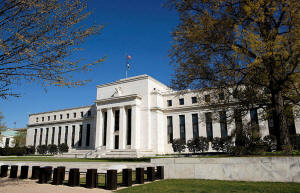Fed in a holding pattern as inflation delays approach to any soft
landing
 Send a link to a friend
Send a link to a friend
 [April 29, 2024] By
Howard Schneider [April 29, 2024] By
Howard Schneider
WASHINGTON (Reuters) - Inflation showing no recent sign of slowing or
narrowing in scope leaves U.S. Federal Reserve policymakers challenged
this week over how to characterize their next steps even as the
countdown to a contentious U.S. presidential election continues.
The Fed is seen holding its benchmark interest rate steady at
5.25%-to-5.5% at its April 30-May 1 meeting, and a key judgment in the
current policy statement - that inflation "remains elevated" - may have
to remain in place after the pace of price increases accelerated over
the first three months of the year after steadily slowing through 2023.
Details of the most recent price reports, moreover, showed high
inflation lodged across a wide array of goods and services, something
current voters on interest rate policy including Atlanta Fed President
Raphael Bostic and Richmond Fed President Thomas Barkin have focused on
as a reason to be wary of cutting interest rates.
Data from March, for example, showed that more than half of the items in
the personal consumption expenditures price index - used by the Fed to
set its 2% inflation target - saw inflation of greater than 3%, well
above the share common before the pandemic.
"The Fed has simply run into a brick wall," Citi Global Chief Economist
Nathan Sheets said after data released on Friday showed the PCE index
increased at a 2.7% annual pace in March versus 2.5% in February, while
the number stripped of volatile food and energy prices was 2.8%,
matching February. "This is very strong data and it is not data that has
given them any confidence they are meaningfully on their way to 2%...The
Fed is simply going to have to wait."

SEEKING 'GREATER CONFIDENCE'
Many analysts still expect inflation to move lower over the year,
eventually allowing policymakers to call the first quarter a "bump" on
the path back towards 2% and proceed with rates cuts they have been
preparing for since late last year.
But progress could be slow, and investors have already pushed their
outlook for an initial Fed rate reduction to September. That would be in
the thick of a U.S. presidential election where the state of the economy
may be a central issue - and Fed decisions inevitably parsed through a
political lens.
The Fed's next policy decision will be released on May 1 at 2 p.m. EDT
(1800 GMT) with a press conference by Fed Chair Jerome Powell following
at 2:30 p.m. (1830 GMT)
With no new economic projections due, the policy statement and Powell's
remarks will anchor whatever guidance may come.
After months that have held hints of economic slowing, including
first-quarter economic growth at 1.6% that was the weakest in nearly two
years, alongside strong price increases and job growth, there may be
little to change officials' current strategy of delaying rate cuts until
the data show a convincing turn.
Policymaker projections in March signaled three quarter-point rate cuts
by the end of the year, with markets geared for the first in June.
Powell's last public comments before this week's meeting suggest that
outlook has eroded.
[to top of second column] |

The Federal Reserve building stands in Washington April 3, 2012.
REUTERS/Joshua Roberts/File Photo

"The recent data have clearly not given us greater confidence" that
inflation will resume its decline, Powell said in comments to a
forum in Washington on April 16. "Right now, given the strength of
the labor market and progress on inflation so far, it's appropriate
to allow restrictive policy further time to work and let the data
and the evolving outlook guide us."
That general message is likely to get repeated, said J.P. Morgan
economist Michael Feroli.
"The post-meeting statement will be little changed from the one
released after the previous meeting in March," Feroli wrote, while
Powell is likely to reemphasize the Fed will delay rate cuts as long
as needed but also be ready to move sooner if the data warrant.
A POLITICAL SEASON
Fed officials have downplayed a need for another rate increase. The
current rate was set in July, a nine-month plateau that already
exceeds three of the five prior policy cycles, but still short of
the 15- and 18-month holds just before the global financial crisis
in 2007 and in the late 1990s.
New projections will be issued in June, and Feroli said he
anticipated that Powell "will not defend the March dot plot as still
being a relevant guide to the policy outlook."
Indeed investors now see perhaps only a single cut this year,
currently anticipated in September.
The delay, and the sticky inflation that has prompted it, has thrown
an unexpected wrinkle into what as of late last year seemed a coming
"soft landing" from high inflation. It was something that cheered
Fed officials and set the stage for President Joe Biden to envision
campaigning on weakening price hikes, still-low unemployment, and
falling interest rates for good measure.
Unless the data move strongly to show inflation falling fast or the
economy weakening, some see a September cut putting the Fed under a
political microscope it would prefer to avoid - particularly given
the animosity Republican candidate Donald Trump holds towards Powell
for raising rates when Trump was president.
Even if their motivations are data driven and apolitical, optics may
argue for avoiding any decisions in the fall, said Vincent Reinhart,
chief economist at Dreyfus and Mellon and former head of the Fed's
monetary affairs division.
After May, the Fed has meetings in June, July, September, November
following the election, and December. "To preserve your reputational
capital, June and December are the safest harbors," Reinhart
said.The Fed seemed to be favoring June, he said. But "the data
ruled that out."
(Reporting by Howard Schneider; Editing by Dan Burns and Andrea
Ricci)
[© 2024 Thomson Reuters. All rights
reserved.]
This material may not be published,
broadcast, rewritten or redistributed.
Thompson Reuters is solely responsible for this content.
 |